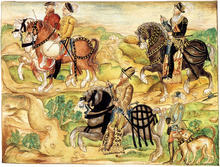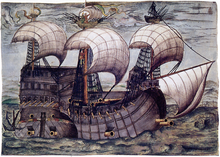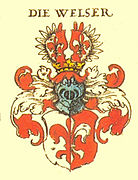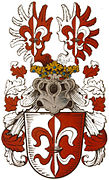Welser
Welser is the name of an Augsburg and Nuremberg patrician family of large merchants. The Welser can be traced in Augsburg since 1246. In the Middle Ages, the Wels factories operated in Antwerp , Lyon , Madrid , Nuremberg, Seville , Lisbon , Venice and Rome as well as Santo Domingo and Venezuela . These Upper German merchants made wealth through their trade and financed rulers of various European states.
history
The Welsersche Handelsgesellschaft
A Welser trading company is first recorded in Augsburg in 1420. Anton I. Welser the Elder founded the Welser-Vöhlin-Gesellschaft in 1498 with the Memmingen trading house Vöhlin, which was active in the Tyrolean silver trade . The first money was made in the trade in cotton and fuchsia . Trading and mining companies were then another backbone of the Welser's commercial success. Anton Welser the Elder also got into the goods and sea trade with his own fleet, the shipping business and money lending.
The Nuremberg Welsersche Handelsgesellschaft
His younger brother Jakob I. took over the Nuremberg trading post of the Welser in 1493 and became the founder of the Nuremberg line of the Welser, who later called themselves Welser von Neunhof and zu Beerbach .
After the Welser-Vöhlin-Gesellschaft was dissolved in 1517 due to disputes, Jakob I founded the Nuremberg Welsersche Handelsgesellschaft with his sons.
The activities of both Welser trading companies remained closely intertwined. Key positions in copper, tin and silver business were based on the Augsburg Welser, in addition to the Fugger to the great financiers of Charles V belonged. The Nuremberg Welsers were also heavily involved in the tin and copper fields of Thuringia and Bohemia, as well as in the Tyrolean silver mining and mining companies (the latter also did the Fuggers and the Tucher ). In addition to trading in goods, there was a strong commitment to money transactions. Jakob I was one of the Fugger's greatest financiers. In the 16th century, the spice trade was added to emphasize the Nuremberg trading center. Alongside the Imhoff and the Tucher , the Welser were among the most important saffron traders . Together with Martin Pfinzing , Hans Welser was elected as the first supreme market lord to the trading board of the Nuremberg Stock Exchange .
The Nuremberg Welsersche Handelsgesellschaft had trading bases in Lisbon, Seville, Lyon, Antwerp, Cologne, Augsburg, Venice, Verona, Milan, Genoa, Aquila and Naples, among others.
With the Plata expedition of 1536, in which the Nuremberg Welsers and the Fuggers were also involved, the attempt to conquer Peru failed; the Spaniards got ahead of them.
The spice trade
In 1505 the trading company Welser-Vöhlin- Fugger - Höchstetter -Gossembrot- Imhoff - Hirschvogel equipped Portuguese ships for one of the first trade trips of Upper German merchants to India in order to open up the overseas spice markets . With 20,000 cruzados, the Welsers financed by far the largest proportion of financial merchants from Italy and Germany. In addition to the trading company, the Florentine Bartholomé Marchione was also involved in the trip. The young Ferdinand Magellan also gained his first seafaring experience on this trip. There were enormous profits in the spice trade back then.
The merchant Balthasar Sprenger sent by the Welsern delivered an impressive report on the India voyage from 1505 to 1506 from Lisbon to Kochi and Calicut in his book "Sea Voyage" from 1509.
In this and many other trading companies, Nuremberg patricians were actively involved in trading. In many cases, however, they or their family members were also silent partners.
The Venezuela Treaty

Emperor Charles V left Bartholomäus V. Welser, who directed the fortunes of the Augsburg Welser Society from 1519 to 1551, in a so-called Asiento, a general contract of March 27, 1528, in return for a loan granted to him, the governorship of the Spanish Overseas Province of Venezuela . With the help of this contract, Charles V wanted to open up the colonies quickly and free of charge in return for appropriate concessions. Welser financed the fleet of ships, their crews and equipment and received Venezuela as a temporary fief. For the Welser, the establishment of a colonial means the creation of a safe base for their American and international long-distance trade.
Previously, in the contract of February 12, 1528 with the Spanish court, the Welsers received the monopoly for a license fee of 20,000 ducats to deliver 4,000 African slaves to the Spanish colonies in South America over a period of four years. Between 1529 and 1538 the Welser Society abducted 1005 slaves and sold them outside of Venezuela. Until 1536 the Welsers were part of the slave trade through their merchant and expedition ships and during this time they undertook 45 transports of enslaved people. Besides slaves, gold , pearls, dyes such as indigo , precious woods, drugs and medicines were extremely profitable in the South American trade. The guaiac wood , which allegedly acts against syphilis imported from the New World, was an import hit for the Welsers.
Anton Welser the Younger also traded with Spanish America together with his brother Bartholomäus . The Welsers maintained sugar plantations in Hispaniola and Madeira . Until 1554 the Welsers exploited the natural resources on the Venezuelan coast. The murder of Philipp von Hutten and Bartholomäus Welser on an expedition into the interior of the country in search of El Dorado led to the collapse of Welser rule in Venezuela. With the resignation of Charles V in 1556, the trading rights were lost. The colonial founding of the Welser in Venezuela was the largest part of the Germans in the colonial development of America in the 16th century.
The end of the Welser trading houses
The Nuremberg trading company of the Welser was capitalized after the death of Hans Welser (1534-1601) to support his minor descendants and was dissolved until 1610.
The Augsburg trading company of the Welser was insolvent on July 1, 1614 (so-called "fallit declaration"). The previous trade flows from the Levant , via Italy and the Alps, to the north had shifted. The precious metals from America led to a money and sales crisis. The major debtors of the Welsers - Spain, France and the Netherlands - drove the Welser trading company into ruin with state bankruptcies .
The Welser from Neunhof and zu Beerbach
In 1504 Jakob I. Welser, the founder of the Nuremberg Line, was elected to the “Inner Council” of the imperial city of Nuremberg . Until the end of the imperial city period in 1806, the Nuremberg Welsers were represented in the Inner Council and, according to the " dance statute ", belonged to the "first admitted" sexes eligible for advice.
The descendants of Jakob I acquired the Wunderburg estate from the Pfinzing family in 1572 , Deberndorf near Cadolzburg in 1615 and Mörlach near Hilpoltstein from the Thill in 1633 (Nuremberg patrician family). These seats were lost again in 1658/64.
The Welser were, among other things, financiers of the patrician family Geuder von Heroldsberg related to them . Since the beginning of the Thirty Years War in 1618, the Geuder got increasingly into financial difficulties, and the Nuremberg Welser appeared as creditors. When the Geuder were insolvent, the matter came before the Reichshofrat in Vienna. In the so-called "Laufer Settlement" in 1660, the Welsers were compensated by ownership of the Geuder. The Welser received the entire Geuder share in Neunhof near Lauf, Beerbach , Tauchersreuth with all rights, the Geuder goods in Groß- and Kleingeschaidt, Simonshofen, Dehnberg, Pettensiedel and Letten as well as the ponds in Simonshofen and Laipersdorf.
The Welser called themselves Welser von Neunhof and zu Beerbach from then on . From 1661 they exercised the lower jurisdiction, the preferential rights and the village rule in Groß- and Kleingeschaidt. The entire further development of both places was now closely linked to the development of Neunhof. The Geuder had only reserved the blood ban, which was also ratified by Emperor Leopold in 1661 .
By acquiring the rule of Neunhof, the Welser became members of the Franconian Imperial Knighthood in the knightly canton of Gebürg .
From 1688–1749 the Welsers built three castles there in Neunhof, two of which still belong to them or their family foundation founded in 1539.
The library on the subject of Nuremberg compiled by Paul Carl Welser was retained as the library of the Paul Wolfgang Merkel Family Foundation in the Germanic National Museum.
Enrolled in the simple Bavarian aristocracy in 1814, the Welsers were raised to the Bavarian baron status in 1819 . In 1878 the Nuremberg branch of the family died out, and their property fell to the Ulm Line, as the Augsburg main line, Baron Welser von Zinnenburg since 1567, had already expired in 1797.
Possessions (family foundation - extract)
- since 1685 Welserschloss in Neunhof (main castle, Welserplatz 1)
- since 1660 Castle II in Neunhof ( Altherrenhäuslein or Brille , Welserplatz 2)
Former possessions (extract)
- 1527–1557 Pellerschloss in Fischbach near Nuremberg
- 1551-15 ?? Hirschvogelsaal (also: Hirsvogelsaal ) with property (Sabine Welser)
- 1580-15 ?? Rudolfshausen Castle , Igling
- 1678–1756 Welser Castle in 91207 Neunhof (Lauf an der Pegnitz) (Welserplatz 3, completed in 1695)
- 1684–1688 Eismannsberg manor (Von-Oelhafen-Straße)
- 1688–1978 Kolerschloss in Neunhof (Lauf an der Pegnitz)
- 1739–1743 Brezengarten manor in Nuremberg (Welserstraße / Sulzbacher Straße)
- 17 ?? - 1747 Kleingeschaidt manor near Heroldsberg
- 1795–1812 Weiherhaus mansion near Pillenreuth
- 1795–1812 Königshof mansion near Pillenreuth
The Welserhof in Nuremberg

Jakob Welser bought the "House of the Golden Rose" in the 14./15. Century owned by Stromer , later Krafftsches Haus, and had it rebuilt as a family seat between 1509 and 1512, probably by Hans Beheim the Elder . At the beginning of the 17th century the property was sold again. With wide arches on thin columns, delicate tracery parapets on the two upper floors and a slender stair tower, the Welserhof is the largest and most impressive remaining Nuremberg old town courtyard.
Baron von Welsersche Family Foundation
Jakob I. Welser and his brothers founded the general Welsersche Family Foundation on April 1st, 1539, which still exists today. Over the centuries, new possessions, such as the castles in Neunhof, were brought into the foundation. It was therefore not left to the decision of individual family members to dispose of the goods. After the Nuremberg Line was extinguished, the ownership and administration of the foundation fell to the Ulm Line, which still exists today and was elevated to the status of baron in 1713. Today (as of 2013) Michael von Welser is the administrator of the Freiherrlich von Welsersche Family Foundation.
coat of arms
Family coat of arms
Blazon : The family coat of arms shows a lily of confused color in the shield split from silver and red (also from red and silver) ; on the helmet with red-silver helmet covers an open or closed flight as marked like the shield .
Family coat of arms of the Welser, according to the Augsburg Chronicle, 1457–1487
Family coat of arms of the Barons von Welser on Neunhof ( Bavaria ), between 1900 and 1920
Welser family coat of arms , crowned, after Siebmacher
Welser family coat of arms , crowned, after Siebmacher
Coat of arms graphic by Otto Hupp in the Munich calendar of 1934
Welser's family coat of arms , based on a woodcut by Jost Amman , 1551–1600
Family coat of arms of the Welser family , Bartolomäus Welser , Visitation of Mary in Amberg , Unterallgäu district , Bavaria
Honored coats of arms
In addition to the family coat of arms of the Welsers, there are several coats of arms such as the coat of arms of the Welser von Zinnenberg, the Welser von Rietheim, or the count's coat of arms of the Welser von Welsersheimb (also Welser von Welssersheim ).
Increased coat of arms of the Welser von Zinnenberg , after Siebmacher
Increased coat of arms of the Welser von Rietheim, after Siebmacher
Increased coat of arms of a Wels line, after Siebmacher
Increased coat of arms of a Wels line, after Siebmacher
Increased coat of arms of Count Welser von Welsersheimb, after Siebmacher
Increased coat of arms of Count Welser von Welsersheimb, after Siebmacher , 1790
Increased coat of arms of Count Welser von Welsserheim , after Tyroff
Ulm, Ulm Minster, death shield of Marx Christoff Welser (* 1589; † 1649); Ancestor of the Ulm line of the Welser family with the Welser coat of arms and the Baldinger and Krafft coats of arms
Known family members
Augsburg line
- Bartholomäus I. Welser (* around 1300; † 1349), "Stadtpfleger" in Augsburg, 1330 mayor
- Bartholomäus II. Welser (* around 1347; † 1434), councilor in Augsburg
- Bartholomew III Welser (* 1358; † 1434), master builder and councilor in Augsburg
- Bartholomäus IV. Welser (* 1384; † 1445), merchant and mayor of Augsburg
- Anton I. Welser (born August 17, 1451 Augsburg, † November 9, 1518 Augsburg), merchant in Augsburg, patrician, Augsburg line
- Margarete Welser (* 1481; † 1552), ⚭ 1499 Konrad Peutinger
- Bartholomäus V. Welser ( the elder , also Bartolomé Welser) (born June 25, 1484 Memmingen, † March 23, 1561 Amberg in Central Swabia ), merchant, banker and shipowner
- Anton Welser ( the younger ) (* 1486; † 1557), brother of Bartholomäus V. Welser
- Hans Welser ( the elder) (* 1501; † 1559), Augsburg councilor and mayor
- Bartholomew VI. Welser ( the Younger ) (* 1512; † 1546), son of Bartholomäus V. Welser
- Philippine Welser (* 1527; † 1580), ⚭ Archduke Ferdinand II of Tyrol
- Markus Welser (also Marx Welser) (* 1558; † 1614), humanist, historian, publisher and Augsburg mayor
Nuremberg line
- Jakob I. Welser (born March 13, 1468 Augsburg, † February 14, 1541 Nuremberg), before 1494 citizen of Nuremberg, founder of the Nuremberg line; Nuremberg councilor and patrician, donates the large altar in the Frauenkirche there in 1504; sends Hans Schwerczer to Goa in 1534
- Veronika Welser (*?; † 1530/31), 1503 prioress of the Dominican convent of St. Catherine
- Hans Welser (* 1534; † 1601), Nuremberg councilor, second losunger from 1598 , the last owner of the Nuremberg Welserscher Society.
- Sebald I. Welser (* 1557 in Nuremberg; † September 1, 1589 in Ulm), Nuremberg councilor, donated a substantial scholarship and the Aula (the Auditorium Welserianum) of the University of Altdorf.
- Sebald II. Welser (also Sebaldus Welserus) (born September 6, 1585 in Nuremberg; † July 15, 1626 in Nuremberg)
- Carl Wilhelm Welser von Neunhof (born December 31, 1663; † February 1, 1711 in Nuremberg), mayor of the city of Nuremberg
- Carl Wilhelm Welser von Neunhof (also Carolus Guilielmus Welser von Neunhof, Carolus Wilhelmus Welserus, Karl Wilhelm Welser von und zu Neunhof) (* March 2, 1696; † August 20, 1758), member of the Inner Council of the City of Nuremberg
Ulm Line
- Johann Michael von Welser (* 1808; † 1875), baron, royal Bavarian treasurer, district and trade appeals court director; from 1859 member of the Pegnese Flower Order
- Ludwig von Welser (* 1841; † 1931), Bavarian baron; Legal trainee, then district court assistant; 1892–1902 District President of the Palatinate and 1902–09 of Middle Franconia, co-founder and 1905–1912 first chairman of the Society for Franconian History, from 1867 member of the Pegnese Order of Flowers
- Johann Michael von Welser (* 1869; † 1943), baron, administrative lawyer, state secretary (Weimar Republic)
- Ludwig von Welser (born November 12, 1876 Ramhof / Donauwörth; † May 23, 1958 Donauwörth), baron, locomotive designer ( Joseph Anton von Maffei AG S3 / 6) and historian
Austrian line
- Zeno Welser von Welsersheimb (born December 1, 1835 - February 2, 1921), Baron zu Gumpenstein, count, Austrian politician, Imperial and Royal Defense Minister (1880–1905)
Meeting of the Welser in Wels, Upper Austria
Around the 1990s, at the invitation of the Wels City Tourism Association, people with the surname Welser met once or twice, to which around 100 visitors came.
However, the name of the Welser families is not derived from the city of Wels. (The additional designation in the name of Carl Auer von Welsbach , on the other hand, has reference to Wels.)
See also
- Fugger and Welser Adventure Museum
- Large Ravensburger trading company
- Ambrosius Ehinger
- Nikolaus Federmann
- Bartolome de Las Casas
- History of Venezuela
- Coro (New Augsburg)
- Maracaibo (New Nuremberg)
- Bogotá
- History of the city of Nuremberg
- Castles, palaces and mansions in Nuremberg
- List of Frankish knight families
- Welzer (disambiguation)
literature
- Urs Bitterli : The discovery of America. From Columbus to Alexander von Humboldt. Beck series 1322; Beck, Munich 1999, 544 pages, ISBN 3-406-42122-9 .
- Hartmut Bock: The family history of the Welser. In: Communications from the Association for the History of the City of Nuremberg (MVGN) , 95 (2008), pp. 93–162.
- Johannes Burkhardt : The Welser-Vöhlin Society. Long-distance trade, family relationships and social status at the turn of the Middle Ages to the modern age. In: Wolfgang Jahn u. a. (Ed.): Money and Faith. Life in Protestant imperial cities. Catalog for the exhibition in the Antonierhaus, Memmingen May 12 to October 4, 1998. Publications on Bavarian History and Culture 37/98, Munich 1998, pp. 17–37.
- Jörg Denzer: The conquista of the Augsburg Welser Society in South America (1528–1556). Historical reconstruction, historiography and local culture of remembrance in Colombia and Venezuela ; Series of publications for the journal for corporate history 5; also: Dissertation University of Freiburg (Breisgau), 2003; Munich: Beck, 2005; ISBN 3-406-53484-8 ( reading sample )
- Michael Diefenbacher : Welsersche Handelsgesellschaft . In: Michael Diefenbacher, Rudolf Endres (Hrsg.): Stadtlexikon Nürnberg . 2nd, improved edition. W. Tümmels Verlag, Nuremberg 2000, ISBN 3-921590-69-8 , p. 1171 f . ( Complete edition online ).
- Walter Großhaupt: The Welsers as bankers of the Spanish crown ; in: Scripta Mercaturae, Journal for Economic and Social History 21 (1987), p. 158
- Mark Häberlein, Johannes Burkhardt (Ed.): The Welser. New research on the history and culture of the Upper German trading house ; Colloquia Augustana 16; Berlin: Akademie-Verlag, 2002; ISBN 3-05-003412-2
- Ursula Koenigs-Erffa: The diary of Sebald Welser from 1577 ; in: Communications from the Association for the History of the City of Nuremberg (MVGN) 46 (1955); Pp. 262–371, also online
- F. Roth: Welser . In: Allgemeine Deutsche Biographie (ADB). Volume 41, Duncker & Humblot, Leipzig 1896, pp. 682-692.
- Johann Michael Frhr. v. Welser: Die Welser, Nuremberg 1917, self-published by the Welser Family Foundation,
- Constantin von Wurzbach : Welser and the counts Welser von Welsersheimb, the sex, genealogy . In: Biographisches Lexikon des Kaiserthums Oesterreich . 54th part. Imperial-Royal Court and State Printing House, Vienna 1886, p. 233 f. ( Digitized version ).
- Constantin von Wurzbach : Welser and the counts Welser von Welsersheimb, the sex, coat of arms . In: Biographisches Lexikon des Kaiserthums Oesterreich . 54th part. Imperial and Royal Court and State Printing House, Vienna 1886, p. 241 ( digital copy ).
- Genealogisches Handbuch des Adels , Adelslexikon Volume XVI, Volume 137 of the complete series, CA Starke Verlag , Limburg (Lahn) 2005, ISSN 0435-2408 , pp. 61-63
- Wolfgang Wüst: "... only for your own personal interest, success and benefit"? The Latin America mission of the Augsburg trading company Welser. In: Peter Claus Hartmann / Alois Schmid (ed.): Bavaria in Latin America. Transatlantic connections and intercultural exchange (Journal for Bavarian State History, Supplement 40) Munich 2011, pp. 51–75.
Web links
- Welser patrician and merchant family
- Doris Marszk: South America was conquered in the 16th century with the help of German high finance . In: www.wissenschaft.de, history of February 16, 2001
- Catfish in Venezuela . In: Deutsches Koloniallexikon (1920), Volume III, p. 700 f.
- Hartmut Bock: Giphanius and the legend of origin of the Welser
- A bibliography on the German Welser family
Individual evidence
- ^ Richard Ehrenberg: The old Nuremberg stock exchange. In: Communications from the Association for the History of the City of Nuremberg. Volume 8, Nuremberg 1889, pp. 82-83.
- ↑ Friedrich Mayer: Nuremberg's trade and industry: With special consideration of the present. Nuremberg 1852, p. 53.
-
^ Richard Ehrenberg: The age of the Fugger. Money capital and credit transactions in the 16th century. Volume 1: The Money Powers of the 16th Century. Olms, Hildesheim 1963 (= Jena: Fischer, 1898); P. 96.195.212;
Pius Malekandathil: The Germans, the Portuguese and India. In: Periplus Parerga. 6, LIT, Münster 1999, ISBN 3-8258-4350-5 , p. 47 ff. - ^ Julie Meyer: The emergence of the patriciate in Nuremberg ; in: MVGN 27 (1928), pp. 1–96, here: p. 73.
- ↑ Walter Großhaupt: The Venezuela Treaty of the Welser. In: Scripta Mercaturae. Volume 24, Issue 1/2, St. Katharinen, 1990, pp. 1–35.
- ^ Karl Heinrich Panhorst: Los Alemanes en Venezuela durante el siglo XVI. - Carlos V. y la casa Welser ; Madrid: Editorial Voluntad, 1927 (Panhorst takes into account Spanish sources from the Archivo general de Indias in Seville)
- ↑ Cf. Denzer, Jörg (2002): Die Welser in Venezuela - The failure of their economic goals, in: Häberlein, Mark / Burkhardt, Johannes (ed.): Die Welser. New research on the history and culture of an Upper German trading company. Berlin: Akademie-Verlag, pp. 285-319, p. 304.
- ↑ see B. Ofuatey-Alazard, Nadja (2015a): The European enslavement of African people, in: Arndt, Susan / Ofuatey-Alazard, Nadja (ed.), How racism speaks out of words. (K) Heirs of colonialism in the knowledge archive of the German language. A critical reference work, Münster: Unrast Verlag, 2nd ed., Pp. 103-113.
- ↑ Nina C. Wiesner, Georg Pencz: The ceiling painting by Georg Pencz in the Hirschvogelsaal in Nuremberg Olms 2004, 183 pages, ISBN 978-3-487-12532-9 (Volume 154 of Studies on Art History, ISSN 0175-9558 ).
- ↑ From Forth to Lauf ad Peg. The Eppeleinsweg, Verkehrsverbund Großraum Nürnberg (VGN), sockenqualmer.de, p. 13, status 7/2009, July 2009, accessed June 5, 2018. - Also mentions the Kolerschloss.




















